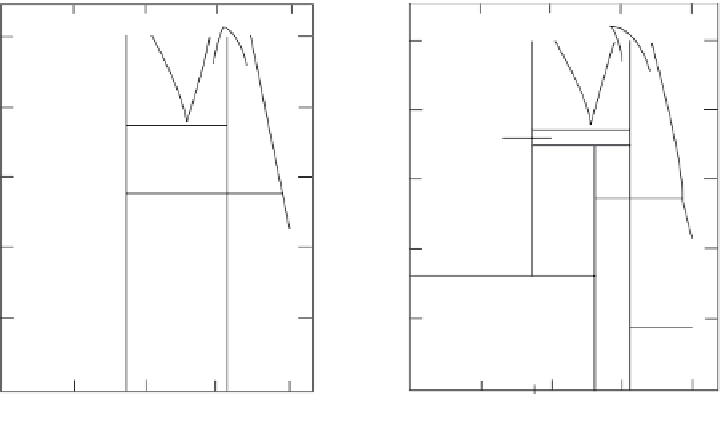Biomedical Engineering Reference
In-Depth Information
The thermal stability of crystalline HA is rather complicated. Figure 6.2 shows the phase
diagrams of CaO-P
2
O
5
system [81] at high temperature without water present (Figure 6.2a)
and with a partial water vapor pressure of 500 mmHg (Figure 6.2b). Various calcium phos-
phate compounds can be found at high temperatures, such as α-C
3
P (α-TCP), C
4
P (TP),
monetite (C
2
P), and mixtures of CaO and C
4
P. It can be seen that crystalline HA is not sta-
ble when the ambient atmosphere contains no water. If the partial water vapor pressure is
increased, then the crystalline HA becomes a stable phase and it can be found in the phase
diagram, as shown in Figure 6.2b. Previous studies reported that the partial dehydration
of HA significantly occurred at a temperature higher than 900°C [82], and the oxyhydroxy-
apatite (OHA) in the form of Ca
10
(PO
4
)
6
(OH)
0.8
O
0.6
⋅V
0.6
may occur when the heating tem-
perature is higher than 1100°C. With increasing heating temperatures higher than 1300°C,
the HA would decompose and the apatite structure changes to a new space group with
the appearance of α-TCP and TP according to the reaction shown in Equation 6.3 [83]. The
α-TCP is resulted from the transformation of β-TCP at temperatures above 1300°C, and the
reaction shown in Equation 6.3 is followed by the reaction shown in Equation 6.4. Thus, it
is generally recognized that the highest temperature of HA without phase decomposition
is about 1300°C in an ambient atmosphere that contains no water.
Ca
10
(PO
4
)
6
(OH)
2
→ 2α-Ca
3
(PO
4
)
2
+ Ca
4
P
2
O
9
+ H
2
O
(6.3)
Ca
4
P
2
O
9
→ α-Ca
3
(PO
4
)
2
+ CaO
(6.4)
The importance of partial water vapor pressure is shown more clearly in Figure 6.3,
which reveals the influence of water vapor pressure on the phase stability of HA. At 1300°C
(a)
(b)
α'C
3
P + Liq
Liquid
α'C
3
P + Liq
Liquid
1700
1700
Liquid
C
4
P
+
Liq.
C
4
P
+
Liq.
1600
1600
1570˚
1570˚
1550˚
α´C
3
P + C
4
P
α´C
3
P + C
4
P
1475˚
α'C
3
P
+
Ap 1475˚
C
4
P + Ap
1500
1500
CaO + C
4
P
(˚C)
(˚C)
αC
3
P
+
Liq.
1400
1400
CaO + C
4
P
αC
3
P + C
4
P
1360˚
αC
3
P + Liq.
1300
1300
CaO + Ap
αC
3
P
+
C
2
P
1200
1200
65
C
4
P
Ap 55 C
3
P 50
Wt. % CaO
P
H
2
O
= 500 mm Hg
70
65
C
4
P 60 55 C
3
P 50
Wt. % CaO Anhydrous equilibria
70
FIGURE 6.2
Phase diagram of the system CaO-P
2
O
5
at high temperature: (a) no water present and (b) partial water vapor
pressure of 500 mmHg. (From Gross et al.,
J. Biomed. Mater. Res.
, 39, 580-587, 1998. With permission.)


Search WWH ::

Custom Search